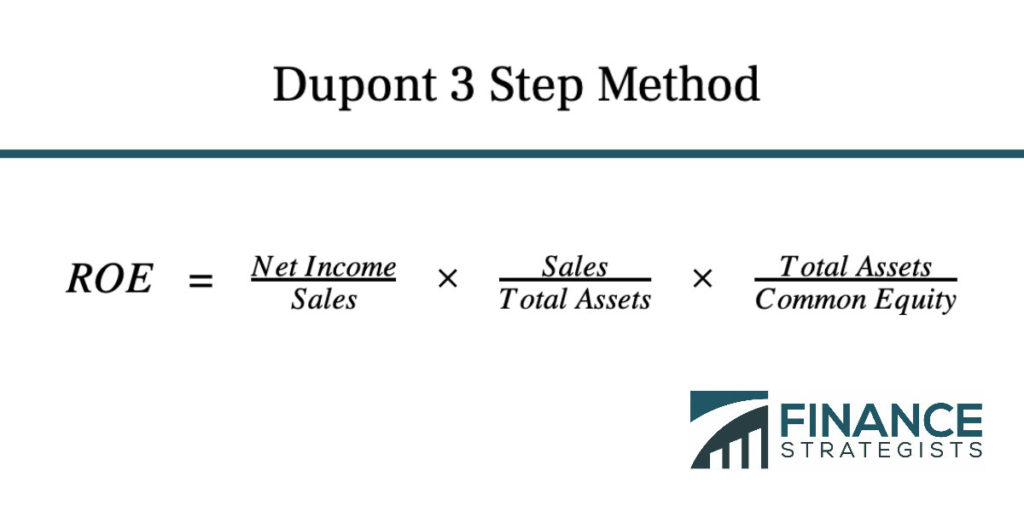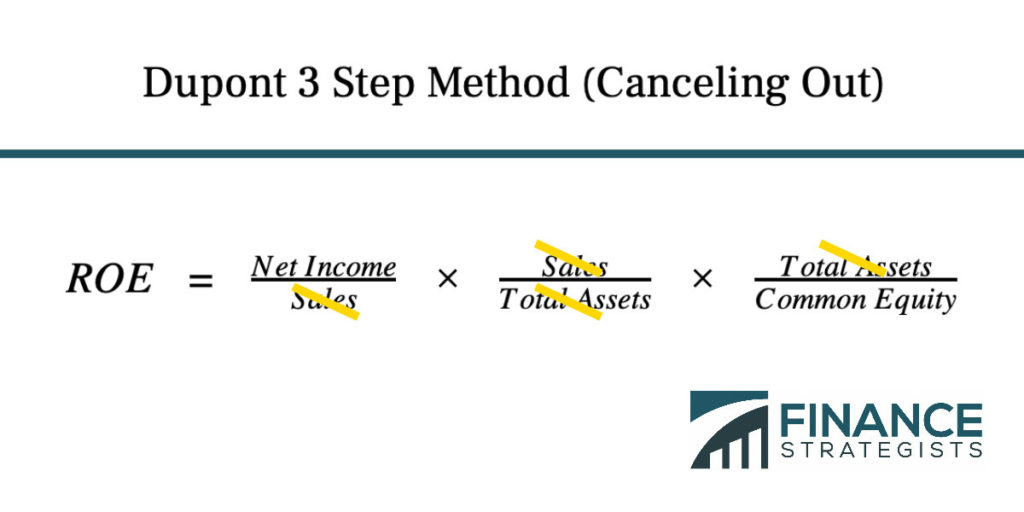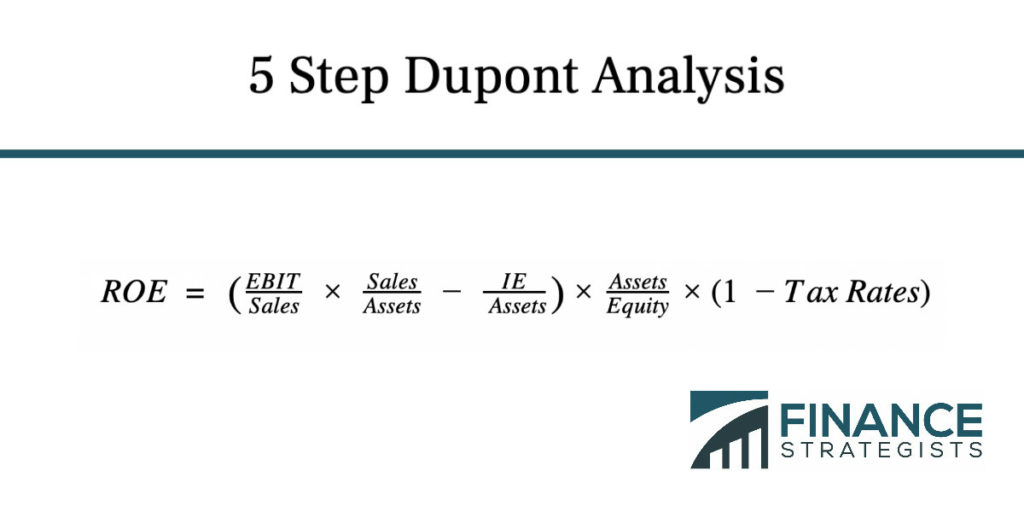The DuPont Analysis Formula is an alternate way to calculate and deconstruct ROE (Return on Equity) in order to get a better understanding of the underlying factors behind a company's ROE. It is done by adding additional factors and data points into the basic ROE equation in order to get a clearer glimpse of what is driving the changes over time in a company's ROE. The DuPont Method has three main components. The first is operating efficiency, which is measured by net profit margin. This shows how much money in net sales is generated per every dollar in expenses. Net profit margin is calculated by dividing net profit, also known as net income, by revenue. The second component, asset efficiency, is measured by total asset turnover. This determines how many dollars of total revenue a company generates per dollar in assets. Total asset turnover is calculated by dividing a company's revenue by the total assets that it has on hand. The third component is financial leverage, determined by the equity multiplier. Unlike the first two components, which directly evaluate a company's operations, financial leverage assesses how well a company is using debt, a key driver of ROE, to finance those operations. The equity multiplier is calculated by dividing a company's assets by its equity. The simplest Dupont formula, the three-step method, is done by simply multiplying the three determinants of three main components--net profit margin, total asset turnover, and equity multiplier--to determine the ROE. When broken down into the calculations for the different components, the Dupont three-step method formula looks like this: This is simply a more detailed version of the basic ROE calculation, which can still be reached by simply cross-canceling out the sales and total assets metrics. There is a second, slightly more detailed version of the Dupont method called the five-step Dupont. This allows investors to see whether a company is propping up its ROE through accumulating debt while suffering from a low profit margin and/or depreciating assets. The individual calculations for determining asset efficiency and financial leverage remains the same, but the net profit margin formula, used to calculate operational efficiency, changes to better show a company's earnings before interest and taxes, or EBIT. The EBIT is calculated by subtracting a company's earnings before taxes (EBT) by its interest expense (IE). The rest of the equation is then multiplied by one minus the tax rate in order to determine the tax hit on a company. When spelled out, the five-step Dupont equation looks like this: The Dupont method is key because Return on Equity is a major component of what an investor looks at when evaluating the performance of various investments. It shows a percentage of how much return on an investment is being made when dividing a company's net profit by its shareholder equity, the total of a company's assets minus its liabilities. For instance, a 10% ROE means that a company is generating 10 cents of profit for every dollar invested. An improving or declining ROE on a year-over-year basis can affect investors' views of that company. Because ROEs can also be inflated by taking on added liabilities, however, smart investors will want to peel back the curtain on which financial metrics are truly contributing t a company's overall ROE, which is where the Dupont method comes in handy. The DuPont Analysis allows analysts to understand where a company is strong and where it is weak when it comes to generating profitability. It gets its name from the company that pioneered the detailed model in the 1920s, the DuPont Corporation. Whereas ROE relies on a simple calculation of net income divided by shareholder equity in order to evaluate a company's performance, the DuPont formula goes deeper, focusing on the three crucial categories of ROE. Both the three-step and five-step Dupont equations allow investors a more thorough glimpse of the year-over-year changes in a company. These equations allow them to better determine whether that company is headed in the right direction in ways that are impossible to examine by looking at ROE alone. Additionally, the DuPont model uses gross asset value, which ignores depreciation, instead of net asset value. This means managers are incentivized to get the most out of the useful life of the assets they already have on hand instead of borrowing more and investing in new assets. Even though the Dupont method goes above and beyond a simple ROE calculation to give investors a better look at a company's operations, profitability, asset value and debt accumulation, it still has limitations. When considering a company's ROE, even with the Dupont formula, investors should keep in mind the average ROE for that company's industry, as well as rival companies' ROEs, and determine where that ROE stands in comparison. The Dupont ratio alone cannot accomplish this.Dupont Analysis Formula
Dupont Equation




Dupont ROE
What Is Dupont Analysis?
Dupont Equation
Dupont Ratio
Dupont Formula and Equation FAQs
The DuPont Analysis Formula is an alternate way to calculate and deconstruct ROE (Return on Equity) in order to get a better understanding of the underlying factors behind a company’s ROE.
The simplest Dupont formula, the three-step method, is done by simply multiplying the three determinants of three main components–net profit margin, total asset turnover, and equity multiplier–to determine the ROE.
The Dupont method is key because Return on Equity is a major component of what an investor looks at when evaluating the performance of various investments.
The DuPont Analysis allows analysts to understand where a company is strong and where it is weak when it comes to generating profitability.
There is a second, slightly more detailed version of the Dupont method called the five-step Dupont. This allows investors to see whether a company is propping up its ROE through accumulating debt while suffering from a low profit margin and/or depreciating assets.
True Tamplin is a published author, public speaker, CEO of UpDigital, and founder of Finance Strategists.
True is a Certified Educator in Personal Finance (CEPF®), author of The Handy Financial Ratios Guide, a member of the Society for Advancing Business Editing and Writing, contributes to his financial education site, Finance Strategists, and has spoken to various financial communities such as the CFA Institute, as well as university students like his Alma mater, Biola University, where he received a bachelor of science in business and data analytics.
To learn more about True, visit his personal website or view his author profiles on Amazon, Nasdaq and Forbes.











